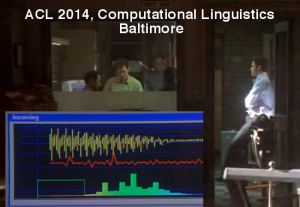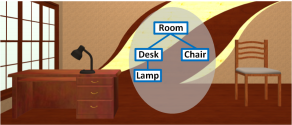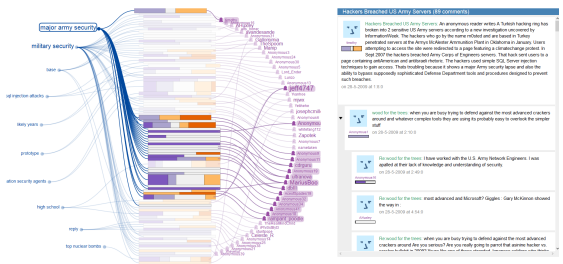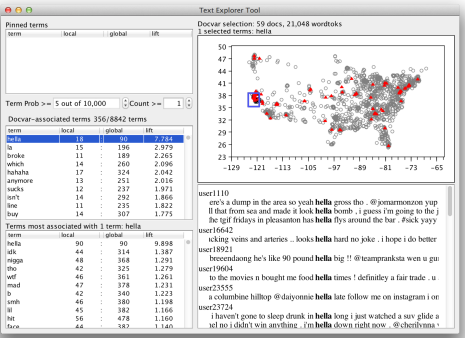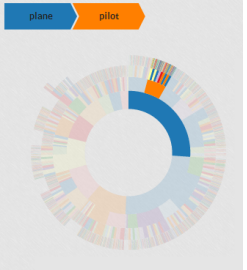We are proud to be sponsor the workshop the workshop on Workshop on Interactive Language Learning, Visualization, and Interfaces at the Annual Meeting of the Association for Computational Linguistics in Baltimore, this week. The conference combines Natural Language Processing (NLP) and Human Computer Interaction (HCI), and was co-organized by my former lab colleague at Stanford, Spence Green.
We awarded travel grants to two students with papers accepted to the workshop:
Enamul Hoque, University of British Columbia, presenting the paper:
Interactive Exploration of Asynchronous Conversations: Applying a User-Centered Approach to Design a Visual Text Analytic System. Enamul Hoque, Giuseppe Carenini and Shafiq Joty
Yi Yang, Northwestern University, presenting the paper:
Active Learning With Constrained Topic Model. Yi Yang, Shimei Pan and Doug Downey
And also awarded a travel grant to an invited speaker:
Chris Culy of Universität Tübingen.
Chris Culy will be speaking about Learning with MOTHs drawing on a wide variety of work in mathematical linguistics, fieldwork in Mali, theoretical morphosyntax, machine translation and summarization.
We congratulate them!
Workshopping what language looks like
The Workshop on Interactive Language Learning, Visualization, and Interfaces tackled this complicated topic from a number of directions.
It was interesting to see both incredible variety and imagination alongside a difficulty in rising above the simple ‘word cloud’ for topics. This was one of the fieriest debates that was repeated through the day: broadly, people offering variations on word cloud technologies, and people offering arguments about why word clouds are not an effective tool for conveying information–the ‘3D pie chart’ of text visualization, as some would claim.
The graphics below taken from the papers show there is much more to this field:
Interactive Learning of Spatial Knowledge for Text to 3D Scene Generation
Angel Chang, Manolis Savva, Chris Manning
GLANCE Visualizes Lexical Phenomena for Language Learning
MeiHua Chen, Shih-Ting Huang, Ting-Hui Kao, Hsun-wen Chiu, Tzu-Hsi Yen
Dynamic Wordclouds and Vennclouds for Exploratory Data Analysis
Glen Coppersmith, Erin Kelly
SPIED: Pattern Based Information Extraction and Diagnostics
Sonal Gupta, Chris Manning
Interactive Exploration of Asynchronous Conversations: Applying a User-Centered Approach to Design a Visual Text Analytic System
Enamul Hoque, Giuseppe Carenini, Shafiq Joty
Design of an Active Learning System With Human Correction for Content Analysis
Nancy McCracken, Jasy Suet Yan Liew, Kevin Crowston
MiTextExplorer: Linked brushing and mutual information for exploratory text data analysis
Brendan O’Connor
LDAVis: A Method for Visualizing and Interpreting Topics
Carson Sievert, Kenneth Shirley
Concurrent Visualization of Relationships Between Words and Topics in Topic Models
Alison Smith, Jason Chuang, Yuening Hu, Jordan Boyd-Graber
Hiérarchie: Visualization for Hierarchical Topic Models
Alison Smith, Timothy Hawes, Meredith Myers
MUCK: A Toolkit for Extracting and Visualizing Semantic Dimensions of Large Text Collections
Rebecca Weiss
Active Learning With Constrained Topic Model
Yi Yang, Shimei Pan, Doug Downey
The invited speakers were:
Chris Culy (Universität Tübingen)
Marti Hearst (University of California, Berkeley)
Jimmy Lin (University of Maryland, College Park)
Noah Smith (Carnegie Mellon University)
Krist Wongsuphasawat (Twitter)
And the conference was organized by:
Jason Chuang (UW)
Spence Green (Stanford)
Marti Hearst (UC Berkeley)
Jeffrey Heer (UW)
Philipp Koehn (Edinburgh)
Whether it’s a quick graph for understanding linguistic trends, or symbolic representations of language for the ages, we look forward to more from these researchers and similar workshops in the future!
Robert Munro
June 2014
